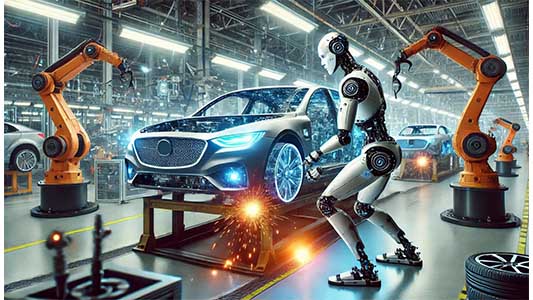Historically, the automotive and logistics sectors have led the charge in adopting automation and robotics, ranging from mobile robots and industrial arms to collaborative robots. Now, in a similar trend, automotive OEMs and warehouse operators are once again taking the lead, this time with humanoid robots. Several industry giants, including BYD and Tesla, have announced plans to increase humanoid robot deployment tenfold over the next year. IDTechEx believes that this is a serious commitment and very likely to happen. This aggressive scale-up is expected to drive down costs significantly, accelerating adoption across factory floors.
According to IDTechEx, this momentum will culminate in the deployment of approximately 1.6 million humanoid robots in the automotive sector by 2035. Their new report, “Humanoid Robots 2025-2035: Technologies, Markets and Opportunities“, outlines a detailed roadmap of how leading players are strategizing this transformation, along with technical, commercial, and regulatory challenges that need to be overcome.
2025 marks a pivotal year, one in which many automotive manufacturers align on a collective belief: humanoid robots are set to become the physical embodiment of AI in the real world. Industry leaders such as Tesla, BMW, Mercedes-Benz, Hyundai, and Xiaomi are actively investing in humanoid robotics, either through startups or in-house development.
IDTechEx believes that there are several strategic reasons for this surge in the automotive industry:
Supply Chain Synergies: Automotive OEMs already possess robust supply chains that overlap significantly with humanoid robot components, such as motors, sensors (e.g., LiDAR and cameras), and batteries. This overlap enables OEMs to scale production efficiently while leveraging their bargaining power to reduce component costs, making humanoid robots more commercially viable across sectors.
Profitability and New Revenue Streams: While humanoid robots are still early in their development, they are well-suited for deployment on automotive factory floors due to their human-like form, allowing seamless integration without reconfiguring existing layouts. In the long term, OEMs envision humanoids reducing labor costs and generating new revenue streams by selling robots to other industries, helping improve thin automotive profit margins.
Currently, factory use cases are limited to tasks like material handling, badge labeling, and inspection. However, technical challenges remain, most notably limited battery life (resulting in over 50% downtime), small payload capacity, and high costs (with prices often exceeding US$100,000 per unit), although IDTechEx forecasts a steady cost decrease, eventually hitting US$20,000 per unit. More details of the humanoid cost and component cost (e.g., sensors, screws, batteries, etc.) are included in IDTechEx’s new market report, “Humanoid Robots 2025-2035: Technologies, Markets and Opportunities”.
Logistics and Warehousing: The Next Frontier
Following closely behind, the logistics and warehousing industry is projected to be the second-largest adopter of humanoid robots. Facing acute labor shortages and rising operational complexity, warehouses are turning to humanoids as a promising solution. These robots bring precision and consistency to repetitive tasks, improving speed while minimizing human error.
The benefits are multifaceted: humanoid robots help lower labor costs, reduce operational disruptions, and offer unmatched flexibility, capable of adapting to varying tasks throughout the day. Their advanced sensors and AI also facilitate better space utilization, potentially increasing storage density in already-crowded facilities. Moreover, their ability to operate continuously without breaks maximizes productivity and extends operational hours.
Yet, widespread adoption is still in its infancy. As of 2025, humanoid deployment in warehouses remains below 5%, reflecting both technological and commercial barriers. Depending on the workload, each unit typically operates for 2-3 hours before requiring an equally long recharge, resulting in substantial downtime. While fast-charging solutions are emerging, they often come with higher costs and shorter battery lifespans.
Commercial viability is another sticking point. With limited field data on ROI and long testing cycles, Amazon reports an 18-month pilot period before scaling decisions, warehouse operators remain cautious. As with autonomous guided vehicles (AGVs) in their early days, humanoids are undergoing extensive evaluation before seeing widespread use.

Timeline for humanoid robots being adopted for different industries. Source: IDTechEx – “Humanoid Robots 2025-2035: Technologies, Markets and Opportunities”
To find out more about IDTechEx’s new “Humanoid Robots 2025-2035: Technologies, Markets and Opportunities” report, including downloadable sample pages, please visit www.IDTechEx.com/HumanoidRobotics.
For the full portfolio of robotics market research available from IDTechEx, please see www.IDTechEx.com/Research/Robotics.












